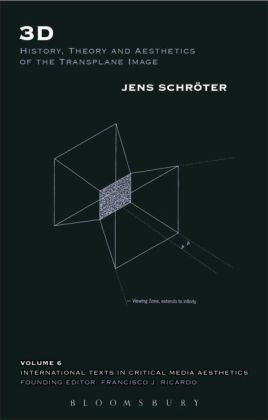Read more
There is a blind spot in recent accounts of the history, theory and aesthetics of optical media: namely, the field of the three-dimensional, or trans-plane, image. It has been widely used in the 20th century for very different practices - military, scientific and medical visualization - precisely because it can provide more spatial information. And now in the 21st century, television and film are employing the method even more. Appearing for the first time in English, Jens Schroter's comprehensive study of the aesthetics of the 3D image is a major scholarly addition to this evolving field. Citing case studies from the history of both technology and the arts, this wide-ranging and authoritative book charts the development in the theory and practice of three-dimensional images. Discussing and analyzing the transformation of the socio-cultural and technological milieu, Schroter has produced a work of scholarship that combines impressive historical scope with contemporary theoretical arguments.
List of contents
Preface / Theory - Method / 1. Theory, Method, and Outline / 1.1. Jonathan Crary's Techniques of the Observer / 1.1.1. Charting the Techniques of the Observer / 1.1.2. Inconsistencies in Crary's Approach / 1.2 Towards an Alternative Model of Media History / 1.2.1. Layers - Not Succession / 1.2.2. Discontinuity and Continuity: Which Foucault? / 1.2.3. The Four Optical Series / 1.3 A Short Comment on Optics and Optical Media / 1.4. Transplane Images and The Production of Space (Henri Lefebvre) 3D / 1.5. Spatial Knowlegde and the Media Aesthetics of Transplane Images / 1.6. Summary / Case Studies / 2. 1851: Sir David Brewster and the Stereoscopic Reproduction of Sculptures. The Series of Physiological Optics I / 3. 1860ff.: Photo-Sculptures. The Series of Virtual Optics I. / Media Aesthetics of Transplane Images I / Karin Sander: PEOPLE 1:10 (1998-2001) / Media Aesthetics of Transplane Images II: THE MATRIX (1999) / 4. 1891: Lippmann Photography / The Series of Wave-Optics I / 5. 1908ff.: Integral Photography. Lenticular Images / The Series of Geometrical Optics??Usage and Manipulation / Media Aesthetics of Transplane Images III: Mariko Mori: BIRTH OF A STAR (1995) / 6. 1935ff. "A People Without Space"?? A People With Stereoscopy / Stereoscopy in the Third Reich / The Series of Physiological Optics II / The Politics of Transplane Images I / Media Aesthetics of Transplane Images IV: Thomas Ruff: RUHRGEBIET I (1996) / 7. 1918-1935: Media Aesthetics of Transplane Images V:Marcel Duchamp: From Projection to Rotoreliefs / 8. 1948ff.: The Volumetric Display. / The Series of Physiological Optics III. The Series of Virtual Optics II. / The Politics of Transplane Images II. / Media Aesthetics of Transplane Images VI and VII:Jenny Holzer: LUSTMORD (1994-1996) and Olafur Eliasson: CONVEX/CONCAVE (1995/2000) / 9. 1946ff.: Holography. The Series of Wave Optics II / 9.1. Principle, Genesis, Theoretical Reflections of Holography / 9.2. The Spatial Knowledge of Holo-Interferometry / 9.3. Wave Optics and Simulation of Geometrical Optics: Holographic-Optical / Elements. Optical vs. Visual Media / 9.4. Media Aesthetics of Transplane Images VIII. / Artistic Holography: Illusionism, Light and Achronisms / 9.5 Results / 10. 1960ff.: Repetition and Difference / On the Series of Virtual Optics III. / The Interactive-Transplane Image / 11. Conclusion
About the author
Jens Schröter is Professor of Theory and Practice of Multimedia Systems in the Department of Media Studies, University of Siegen, Germany, and is also the co-editor, with Stefan Rieger, of Das holographische Wissen, Berlin (2009).
Report
What if, instead of writing the history of those things that have become the cultural dominant, we were to write the history of the overlooked - of those other, non-victorious cultural forms that the march of history pushed into the shade? And what if the history in question is that of visual media, from Daguerre to the present?
Jens Schröter's inquiry begins as a project of 'minor' history, tracing the development of one among the many visual media existing in the shadows of the dominant: the 3-D (or 'transplane') image. In the course of excavating this particular terrain something larger and more dangerous is unearthed: the systematic blind-spots, exclusions, red herrings, and cul-de-sacs that have helped to shape the shiny new discipline of the history of visuality. Warning: this book may cause the reader to lose faith in a number of cherished beliefs concerning visual regimes and their periodization, and the viability of such concepts as embodied spectatorship, the physiological paradigm of vision, and the theoretical fiction known as 'the observer.
Norman Bryson, Professor of Art History, Theory, and Criticism, University of California, San Diego, USA

